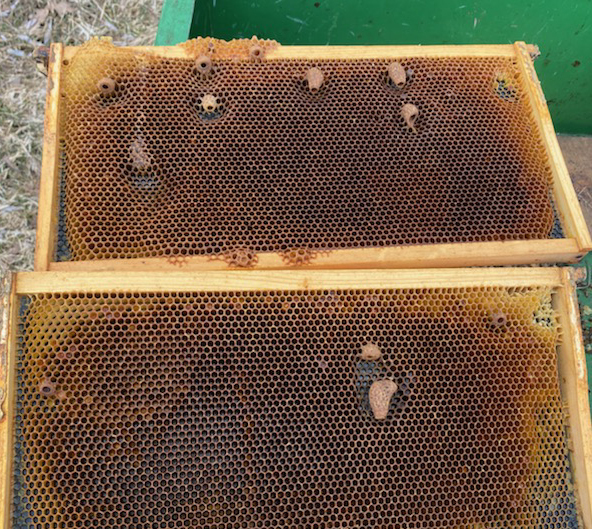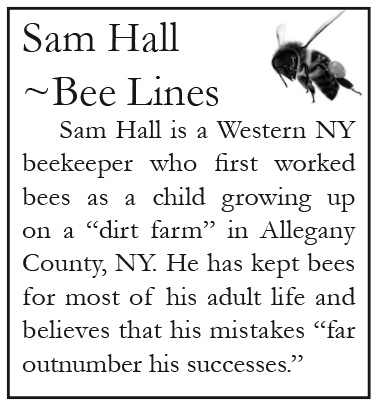Bee Lines: Spring Surprises and Queen Conundrums
- SAM HALL –
As I’m starting to write this note, the temperature is 25 degrees with an icy wind blowing at about 15 mph from the west-north-west making it feel like zero or below. However, a few days from now it is predicted to be in the 50s. I am looking forward to it and the bees have been spending the last several days getting ready. Normally, in January we have the “January thaw.” This year it was only about a day and really was not that warm. Most of my bees did not do any substantial “cleansing flights” that day and I’m hoping they are okay. The cleansing flights are when they leave the hive and defecate for the first time in several months.
Today, March 10th, the temperature is supposed to reach 60. Yesterday it was 45° in my yard and while the bees were not flying far, they were out. It appears I have fifteen colonies that have survived this far. I have four that are dead outs. I believe the large survival number is due to three things. First instead of wrapping exposed hives in tar paper I used “Bee Cozy” wraps, which gave them much more protection due to the quilt like quality of the fabric. They cost around $25 but you can reuse them for five years or perhaps longer. Spread over five years, the cost is about $5 per year. Compared to the costs of a new nuc at roughly $150+ it makes sense to try them. Secondly, I left a lot more honey on than I usually do as I was lazy and didn’t want to feed if I could avoid it. Thirdly, it was a milder than normal winter.
There was a surprise—no, shock is the more appropriate adjective. I had an eight frame colony with one deep and a honey super on top. I did not wrap or insulate this colony as it was not strong, and I did not expect it would make it. I saw a lot of dead bees (hundreds if not a couple of thousands) outside in front of the hive. There were a lot of feces that looked like they had a bout of dysentery or maybe nosema.

To my surprise, the bees who were only going in and out of the honey super on top did not seem agitated like robber bees—which is what I thought they were. When I removed the honey super and started to go through the bottom deep, I ran into sealed brood and a fair number of bees and, finally, ran onto a great looking unmarked queen. I immediately closed the hive back up, got some 2 to1 syrup which I had in a Boardman feeder and started feeding them. No bees were going in and out of the bottom deep from the landing or bottom board even though there was no entrance reducer on.
Currently there is very little for the bees to bring in except for skunk cabbage; the catkins on the willows are not ready yet. I have prepared a 1 to1 syrup of sugar and water which I have put into a yard feeder so all can access it.
My #3 colony struggled all of last year trying to find the right queen. They would raise their own then dispose of her. I introduced a purchased queen which they released, and I saw her for a while on the frames then she eventually disappeared. When I took this dead out apart the frames told the story of their search for a queen with a number of empty unused queen cells. Not sure what the story is but I do have a theory. I have read and heard about super sisters in a colony. The queen is the mother of all but the bees have different fathers. A group of workers that were fathered by sperm from the same drone are referred to as “super sisters.” One of the things they will do when the colony is going to swarm and several swarm queen cells have been filled and sealed (one of which contains a sister) is to go around putting more wax on the tips of the other queen cells trying to insure their sister queen will emerge first and thence dispose of her rivals. In the case of my conundrum, what if there were two sets of super sisters in the same colony? It would explain I believe what happened in #3. The pictures I took of the frames are shown below. I would be interested if anyone has another more plausible explanation.

The eastern side of my double nuc box has survived but not the one that was facing west in spite of my putting straw bales three-deep to block out the western wind and putting it in a better location.
Honey bees never will cease to be a fascination for me and I hope for you. Having 15 colonies survive means I will be making a lot of splits, but I don’t kid myself; in spite of my best efforts there will be swarming, probably lots of it. I will admit that there is something of awe I feel inside myself when I see a swarm in a bush or tree. This is nature doing her (or is it his) thing.
